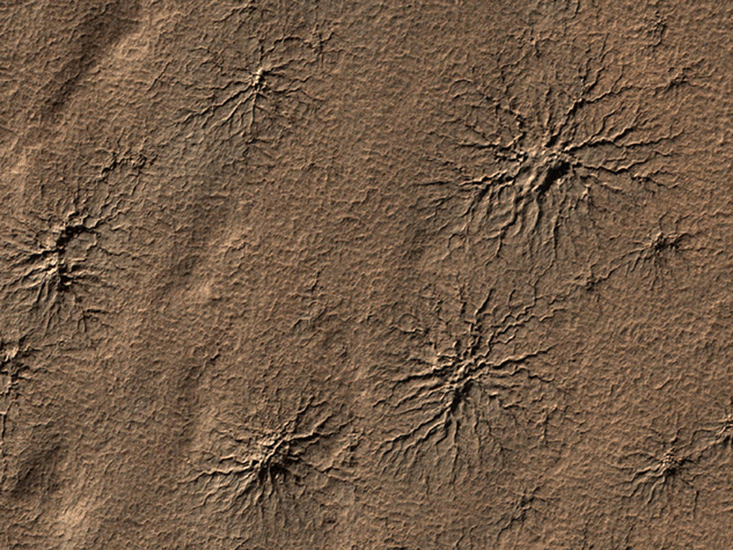Mars is currently inhabited by an estimated 1 million microbes. They coat the surfaces and crowd the innards of our robotic landers and rovers, which international policy requires to be cleaned, but not fully sterilized. The bugs are dormant, but viable. If Mars warmed up and water began to flow again, these microorganisms would revive and reproduce. And it is within our power to make that happen.
The concept of terraforming—making a barren world suitable for widespread life—is well developed in science fiction. The term was first used in a science-fiction story published in 1942. It implies the creation of a copy of Earth, which need not be the goal, but the word caught on. (It is definitely more euphonious than the suggested alternatives of “ecopoiesis” or “planetary ecosynthesis.”) In the ’90s the award-winning science-fiction trilogy by Kim Stanley Robinson, Red Mars, Green Mars, and Blue Mars centered on the science and ethics of terraforming. But terraforming is no longer just science fiction.

I have been fascinated by terraforming for my entire professional life. I feel that, within the natural world, we can find meaning and value in the phenomenon of life. Moreover, we humans are in position to enlarge that value by contributing to the richness and diversity of life in the universe. That begins on Earth with stewardship of life here. But because of the unique capabilities of humans, we can envisage expanding life beyond the Earth. Mars is the first real test of our motivation and ability to do this.
Of all the other worlds in our solar system, only Mars has a realistic potential for terraforming. Our investigations of the planet have shown that it was habitable in the past, so it should have all the ingredients to recover its former glory. The primary challenge is to warm the planet. And warming planets is a technology that we humans are all too good at.
From what we can tell, Mars has the key materials to construct a biosphere: water, nitrogen, and carbon dioxide. Missions over the past decade have established that the high latitudes are rich in water ice, and the Curiosity rover recently detected nitrate in the soil (about 0.03 percent by mass). Carbon dioxide is the main wildcard. Mars may have vast layers of carbonate minerals, but this form of carbon dioxide is not easily released as gas. The success of terraforming would hinge on the south polar cap and the polar soil. They may contain enough carbon dioxide to bulk up the atmosphere only slightly, or they could store enough to create a pressure on Mars equal to the sea-level pressure on Earth.
In the latter case, studies of the climate of Mars indicate that it has two points of stability. Its current climate, with a thin atmosphere, a thick polar cap, and an average surface temperature of –60 degrees Celsius, is stable. But Mars has a second stable climate state, with a thick atmosphere, a thin polar cap, and temperatures of 15 degrees Celsius. That is what makes terraforming Mars feasible. If we could push its climate from the first state to the second, the clement conditions would be self-sustaining.
How would we respond if Mars turns out to have life of its own?
That could happen extremely rapidly. To judge from how quickly our greenhouse emissions are warming Earth, we could shift Mars into a warm climate state within 100 years. The most efficient technique would be to produce supergreenhouse gases such as chlorofluorocarbons or, better, perfluorinated compounds, which are not toxic, do not interfere with the development of an ozone layer, and resist destruction by solar ultraviolet radiation. Curiosity has recently confirmed the presence of fluorine in the rocks on Mars, so the ingredients are all there.

Once Mars is warm, water will begin to flow across the surface, and an Earth-like hydrological cycle will take hold. Photosynthetic organisms will be able to thrive, and they will turn soil nitrates and perchlorates into nitrogen and oxygen gas. Humans will be able to walk around without a space suit, although they will still need an oxygen mask.
From that point on, the terraforming project will focus on building up the oxygen. For humans to breathe naturally requires oxygen levels above 13 percent and carbon dioxide levels below 1 percent. On Earth, the global biosphere uses sunlight to produce biomass and oxygen with an energy conversion efficiency of 0.01 percent. At that rate, it would take 100,000 years to produce an Earth-like atmosphere on Mars. The 0.01-percent is averaged over oceans, deserts, and forests. The intrinsic efficiency of photosynthesis in terms of a unit leaf is much higher, about 5 percent. If that could be achieved over the entire area of Mars, the timescale becomes a few hundred years. Synthetic biology may be able to speed it up further.
As is often the case in science, the deciding factors may not be technological, but social and ethical. For instance, how would we respond if Mars turns out to have life of its own? As a first step, we would need to determine how Martian life is related to Earth life. The two might well be the same form of life, having originated on one world and spread to the other by meteorites. That might not affect plans for terraforming.
The situation is thornier if Martian life in unrelated to Earth life and clearly represents a second genesis of life. The motivation for altering Mars would not be creating a new habitat for Earth life, but enhancing the richness and diversity of the indigenous Martian life. Our existing landers and probes would need to be removed or sterilized in place, so that any microbial hitchhikers did not overpower the indigenous organisms like interplanetary kudzu.
Presumably, Martian life would be grateful for a terraformed world that restored the planet to what it once was. But the process would take longer and reach a different endpoint than terraforming a lifeless world, since indigenous microbial life might produce oxygen at a slower rate than Earth transplants, or not at all. Whether Mars becomes an outpost of Earth life or a planet-size wilderness refuge, altering it to host a rich and diverse global biosphere would be one of humanity’s greatest creative achievements.
Christopher P. McKay is a senior scientist with the NASA Ames Research Center. McKay has explored ice-covered lakes in Antarctica, permafrost in the Siberian and Canadian Arctic, and the Atacama, Namib, and Sahara deserts to study life in these extreme environments. He was a co-investigator on the Huygens probe to Saturn’s moon Titan in 2005, the Mars Phoenix lander mission in 2008, and the Mars Science Laboratory mission in 2012.
This article was originally published on Nautilus Cosmos in November 2016.


























